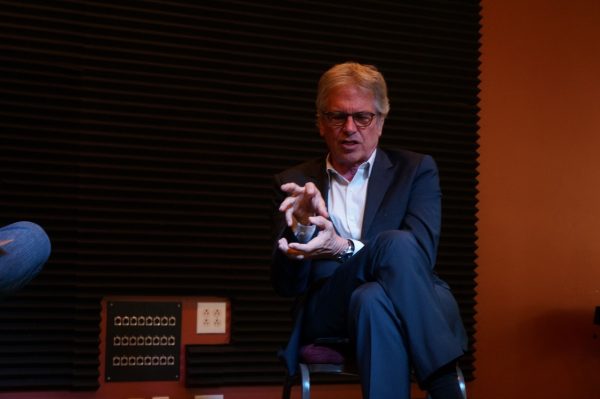Campus chronicle celebrates centennial
1914: A year to be remembered.
On June 28, an assassin killed Archduke Franz Ferdinand of Austria and sparked World War I. On Oct. 13, the Boston Braves won the 1914 World Series.
And, on Oct. 14, The Guilfordian published its first issue.
Guilford College and its student newspaper have changed greatly since the first issue 100 years ago.
Throughout the 20th century, The Guilfordian published weekly issues covering on-campus news and featuring student voices.
The Guilfordian replaced The Collegian, a monthly student literary magazine that occasionally included campus events. It ran from 1888 to 1914, until the board of trustees decided to replace it with a newspaper.
“One reason for this innovation is the indifference of the student body to a purely literary publication,” said an editorial in the first issue. “Not only has The Collegian failed to receive the proper financial support, but also the quantity and quality of the literary contributions have not always been all that could be desired.”
The Guilfordian was originally published as a joint effort of the school’s four literary societies, which functioned as both academic and social clubs. In its first years, The Guilfordian focused on community-submitted club, sports and alumni news.
The coverage reflected different attitudes on campus at a time when enrollment was in the hundreds, not thousands. For instance, The Guilfordian’s advertisement of a blackface troupe in 1917 would have sparked outrage today.
“‘Ye Old N—–s’ are to meet on Saturday, April 21, says the Athletic Cabinet, and the annual minstrel with all its trappings will again be perpetrated on a suffering but thoroly (sic) pleased public,” said a front-page article from March 28, 1917.
The paper gradually dissociated itself from the literary societies as they declined in popularity. It also dropped its $1.00 per year subscription fee and became a free paper supported by student fees.
As time passed, The Guilfordian reflected rapidly changing campus attitudes. An unsigned staff editorial warned of communists infiltrating social movements in the Oct. 12, 1951, issue, published at the height of McCarthyism.
Issues in the 1960s and ‘70s included more and more articles promoting civil rights, the anti-war movement and environmentalism. By March 7, 1974, campus attitudes had changed so much that The Guilfordian published a two-page photo spread of Guilford’s first mass streaking.
Throughout these changes, The Guilfordian remained the primary source of campus information.
“It was read, at least in the circles I traveled in,” said Elwood Parker ’64, professor of mathematics. “When it came out, you picked one up and you read it. Occasionally, there was something in there that got talked about.”
Lacking a faculty advisor and a consistent staff, The Guilfordian was in rough shape by the late ‘70s.
“I had no experience; I had never taken a journalism class or anything like that,” said Professor of English Jim Hood ’79, who was The Guilfordian’s features editor during the 1978 – 1979 academic year. “It was a pretty ragtag organization in some ways.”
The paper stopped publishing on several occasions due to a lack of quality submissions. In 1932, the majority of the Guilford student body voted to disband the paper. The paper folded again in fall 1986 when Dana Professor of English Jeff Jeske joined the faculty.
“I had no background in journalism whatsoever, other than contributing to an underground Latin newspaper at the Jesuit high school I got expelled from,” said Jeske. “When (The Guilfordian) went belly-up, I chortled and thought ‘Good riddance.’”
Despite this, the academic dean asked Jeske to be The Guilfordian’s new faculty advisor, a position which he accepted. Jeske started developing classes to go along with the paper to ensure that it would always have a knowledgeable staff. The Guilfordian eventually grew to its present status as an award-winning student paper.
Few people from The Guilfordian’s past staff could anticipate Guilford and the paper’s current status. In 1962, a writer speculated that in 50 years, jet packs would be a primary mode of transportation off-campus.
No one knows what Guilford will be like in 50 or even 100 years from now, but, with any luck, The Guilfordian will be around to report on it.





